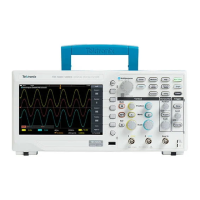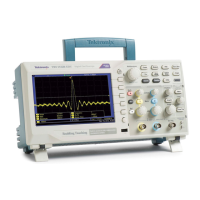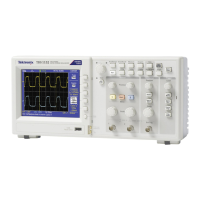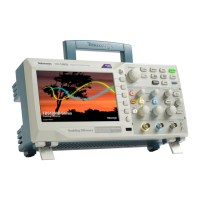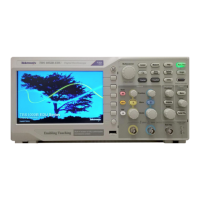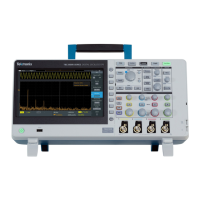Operating Basics
The oscillosco
pe uses several methods to display m enu options:
Page (Submenu) Selection: For some menus, you can use the top option
buttontochoo
se two or three submenus. E ach time you push the top button,
the options change. For example, when you push the top button in the Trigger
Menu, the oscilloscope cycles through the Edge, Video, and Pulse Width
trigger submenus.
Circular List: The oscilloscope sets the parameter to a different value each
time you push the option button. For example, you can push the 1 (channel
1 menu) button and then push the top option button to cycle through the
Vertical (channel) Coupling options.
In some lists, y ou can use the multipurpose knob to select an option. A hint
line tells you when the multipurpose knob can be used, and an LED by the
multipu
rpose k nob lights when the knob is active. (See page 21, Menu and
Control Buttons.)
Action
: The oscilloscope displays the type of action that will immediately
occur when you push an Action option button. For example, when the Help
Index is visible, and you p ush the Page Down option button, the oscilloscope
immediately displays the next page of index entries.
Radio: The oscilloscope uses a different button for each option. The
currently-selected option is highlighted. For example, the oscilloscope
displays various acquisition mode options when you push the Acquire Menu
button. To select an option, push the corresponding button.
Page Selection Circular List
Action Radio
TRIGGER CH1
HELP
ACQUIRE
Type
Edge
Coupling
DC
Page
Up
Sample
or or
Page
Down
Pe
ak Detect
TRIGGER CH1
Average
Type
Video
Coupling
AC
or or
TRIGGER CH1
Type
Pulse
Coupling
Ground
18 TBS1000 Series Oscilloscopes Installation and Safety Manual
